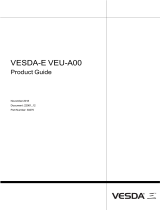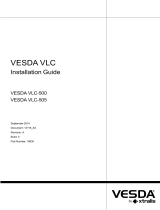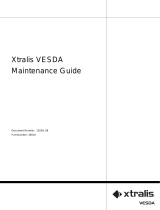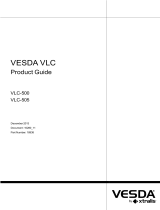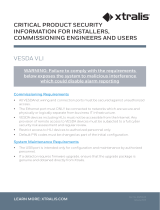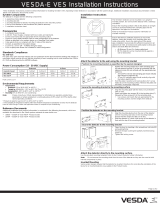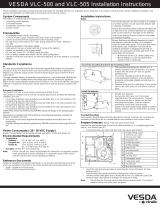Page is loading ...

VESDA-E VEA
Commissioning Guide
October, 2016
Document: 32407_00
Part Number: 30758


VESDA-E VEA Commissioning Guide
32407_00 1
Intellectual Property and Copyright
This document includes registered and unregistered trademarks. All trademarks displayed are the trademarks of their respective
owners. Your use of this document does not constitute or create a licence or any other right to use the name and/or trademark
and/or label.
This document is subject to copyright owned by Xtralis. You agree not to copy, communicate to the public, adapt, distribute,
transfer, sell, modify or publish any contents of this document without the express prior written consent of Xtralis.
Disclaimer
The contents of this document is provided on an “as is” basis. No representation or warranty (either express or implied) is
made as to the completeness, accuracy or reliability of the contents of this document. The manufacturer reserves the right
to change designs or specifications without obligation and without further notice. Except as otherwise provided, all
warranties, express or implied, including without limitation any implied warranties of
merchantability and fitness for a
particular purpose are expressly excluded.
General Warning
This product must only be installed, configured and used strictly in accordance with the General Terms and Conditions,
User Manual and product documents available from Xtralis. All proper health and safety precautions must be taken during
the installation, commissioning and maintenance of the product. The system should not be connected to a power source
until all the components have been installed. Proper safety precautions must be taken during tests and maintenance of the
products when these are still connected to the power source. Failure to do so or tampering with the electronics inside the
products can result in an electric shock causing injury or death and may cause equipment damage. Xtralis is not
responsible and cannot be held accountable for any liability that may arise due to improper use of the equipment and/or
failure to take proper precautions. Only persons trained through an Xtralis accredited training course can install, test and
maintain the system.
Liability
You agree to install, configure and use the products strictly in accordance with the User Manual and product
documents
available from Xtralis.
Xtralis is not liable to you or any other person for incidental, indirect, or consequential loss, expense or damages of
any
kind including without limitation, loss of business, loss of profits or loss of data arising out of your use of the products.
Without limiting this general disclaimer the following specific warnings and disclaimers also apply:
Fitness for Purpose
You agree that you have been provided with a reasonable opportunity to appraise the products and have made your own
independent assessment of the fitness or suitability of the products for your purpose. You acknowledge that you have not
relied on any oral or written information, representation or advice given by or on behalf of Xtralis or its representatives.
Total Liability
To the fullest extent permitted by law that any limitation or exclusion cannot apply, the total liability of Xtralis in relation to
the products is limited to:
I. in the case of services, the cost of having the services supplied again; or
II. in the case of goods, the lowest cost of replacing the goods, acquiring equivalent goods or having the goods repaired.
Indemnification
You agree to fully indemnify and hold Xtralis harmless for any claim, cost, demand or damage (including legal costs on a
full indemnity basis) incurred or which may be incurred arising from your use of the products.
Miscellaneous
If any provision outlined above is found to be invalid or unenforceable by a court of law, such invalidity or unenforceability
will not affect the remainder which will continue in full force and effect. All rights not expressly granted are reserved.

Commissioning Guide VESDA-E VEA
2 32407_00
Document Conventions
The following typographic conventions are used in this document:
Convention
Description
Bold
Used to denote: emphasis. Used for names of menus, menu options,
toolbar buttons
Italics
Used to denote: references to other parts of this document or other
documents. Used for the result of an action.
The following icons are used in this document:
Convention
Description
Caution: This icon is used to indicate that there is a danger to
equipment. The danger could be loss of data, physical damage, or
permanent corruption of configuration details.
Warning: This icon is used to indicate that there is a danger of electric
shock. This may lead to death or permanent injury.
Warning: This icon is used to indicate that there is a danger of inhaling
dangerous substances. This may lead to death or permanent injury.
Contact Us
The Americas
+1 781 740 2223
Asia
+86 21 5240 0077
Australia and New Zealand
+61 3 9936 7000
UK and Europe
+44 1442 242 330
Middle East
+962 6 588 5622
www.xtralis.com

VESDA-E VEA Commissioning Guide
32407_00 3
Codes and Standards Information for Air Sampling Smoke Detection
We strongly recommend that this document is read in conjunction with the appropriate local codes and standards for
smoke detection and electrical connections. This document contains generic product information and some sections
may not comply with all local codes and standards. In these cases, the local codes and standards must
take
precedence. The information below was correct at time of printing but may now be out of date, check with your local
codes, standards and listings for the current restrictions.
FCC Compliance Statement
This equipment has been tested and found to comply with the limits for a Class B digital device, pursuant to part 15 of
the FCC Rules. These limits are designed to provide reasonable protection against harmful interference in a
residential installation. This equipment generates, uses and can radiate radio frequency energy and, if not installed
and used in accordance with the instruction, may cause harmful interference to radio communications. However,
there is no guarantee that interference will not occur in a particular installation. If this equipment does cause harmful
interference to radio or television reception, the user is encouraged to try to correct the interference by one or more of
the following measures; re-orientate or relocate the receiving antenna, increase the separation between the
equipment and receiver, connect the equipment to a power outlet which is on a different power circuit to the receiver
or consult the dealer or an experienced radio/television technician for help.
FDA
This VESDA product incorporates a laser device and is classified as a Class 1 laser product that complies with FDA
regulations 21 CFR 1040.10. The laser is housed in a sealed detector chamber and contains no serviceable parts.
The laser emits invisible light and can be hazardous if viewed with the naked eye. Under no circumstances should the
detector chamber be opened.
FM Hazardous Applications
3611 Hazardous Approval Warning: Exposure to some chemicals may degrade the sealing of relays used on the
detector. Relays used on the detector are marked “TX2-5V”, “G6S-2-5V” or “EC2-5NU”.
VESDA detectors must not be connected or disconnected to a PC while the equipment is powered in an FM Division
2 hazardous (classified) location (defined by FM 3611).
FM Approved Applications
The product must be powered from VPS-100US-120 or VPS-100US-220 only.
ONORM F3014
ONORM F3014, transport times for all tubes (including capillaries) must not exceed 60 seconds from any hole. This
means that the pre-designed pipe networks that include capillaries cannot be used.
AS1603.8
The performance of this product is dependent upon the configuration of the pipe network. Any extensions or
modifications to the pipe network may cause the product to stop working correctly. You must check that ASPIRE2
approves alterations before making any changes. ASPIRE2 is available from your VESDA ASD distributor.
AS1851.1 2005
Maintenance Standards. Wherever this document and the AS1851.1 differ, AS1851.1 should be followed in
preference to this document.
European Installations
The product must use a power supply conforming to EN54: Part 4.

Commissioning Guide VESDA-E VEA
4 32407_00
This page is intentionally left blank

VESDA-E VEA Commissioning Guide
32407_00 5
Contents
Introduction to VESDA-E VEA Commissioning ....................................................................... 7
1
The Commissioning Process ..................................................................................................... 8 2
2.1 Pre-Commissioning (before going to site) ..................................................................... 8
2.2 Pre-Commissioning (on site) ........................................................................................... 8
2.3 Configuration ..................................................................................................................... 9
NFPA72 Code Compliance ....................................................................................................... 10 3
3.1 NFPA72 Requirements ................................................................................................... 10
Commissioning Tests ............................................................................................................... 11 4
4.1 Initial Tests....................................................................................................................... 11
4.2 Functional Tests .............................................................................................................. 12
4.3 Smoke Tests .................................................................................................................... 12
4.4 Walk Test .......................................................................................................................... 13
Annex A: VESDA-E VEA Configuration Record ............................................................................... 14
ANNEX B: VESDA-E VEA Commissioning Form .............................................................................. 16

Commissioning Guide VESDA-E VEA
6 32407_00
Scope
The VESDA-E VEA Commissioning Guide outlines the commissioning process for the VESDA-E VEA
detector. It will guide you through the commission process and the completion of commissioning
documentation. The guide also provides information on the approval and handover of commissioned VESDA-
E VEA detectors.
The Commissioning Guide helps with the commissioning and management of the VESDA-E VEA detector.
This guide assumes that you have attended accredited VESDA training on commissioning and are
knowledgeable about the VESDA product range. This guide also assumes that you have an understanding of
the various aspects of an aspirating smoke detection system and are fully aware of the local codes and
standards.
To commission the VESDA-E VEA detector, you must have the necessary certification issued by Xtralis or an
authorized distributor. Commissioning before you receive the appropriate training may void the warranty.

VESDA-E VEA Commissioning Guide
32407_00 7
Introduction to VESDA-E VEA Commissioning 1
Commissioning is the final stage of the system installation. It forges together the elements of designing and
installing the tubes, installing the detector(s), cabling for power and communications, and the powering up of
the detector. The objective and outcome of the commissioning process is to provide a fully functional
VESDA-E VEA detector that matches local code requirements and customer specification.

Commissioning Guide VESDA-E VEA
8 32407_00
The Commissioning Process 2
The commissioning process is a step-by-step process designed to systematically check and validate all the
operational aspects of the VESDA-E VEA detector. The process benchmarks the performance levels tailored
for each site and generates the necessary documentation for the effective management and maintenance of
the detector. The following sections describe the steps required in typical commissioning.
2.1 Pre-Commissioning (before going to site)
Prior to starting the commissioning process, the commissioning engineer should study any design and
installation considerations for the site. Properly maintained tube network design and installation records
should assist in providing most of the information. Ensure that the following documents are available:
The site layout plans
The "as installed" drawings for the site
Tube network design records
Tube network installation record
Relevant product and installation guides (VEA-040-A00 and VEA-040-A10 product guides (documents #
27034 and 27035 respectively), VESDA-E VEA Installation Sheet (Document # 27679))
VESDA-E VEA commissioning form
Other forms as required by the local codes and standards
A USB cable and PC/Laptop with Xtralis VSC software to configure and commission the detector
Material for conducting acceptable smoke test
You must be aware of the local codes and standards as applicable to the customer site.
2.2 Pre-Commissioning (on site)
Before commencing with the commissioning, check the electrical and interface cabling for the detector.
Ensure that all electrical wiring is securely terminated maintaining the correct polarity. The product guides
contain the details on how to correctly wire the detector. The detector should be connected to a power
source supplying 24 VDC.
Caution!
VESDA-E VEA detector will not operate when the supply is reversed.
Operating the VEA detector when DC supply voltage is outside the voltage
range of 18 VDC and 30 VDC may cause damage to the device.
Please check that all electrical installations meet the requirements of local electrical codes and standards.
Ensure that actual installed tubes match the design and the installation records including the
combination of 6mm and 4mm tubes designed using Microbore Tube Length Calculator (document
#29261).
Please follow the instructions mentioned in VESDA-E VEA Intallation Sheet, document #27679, for VEA
detector mounting.
Ensure that you have at least 0.5m distance from the detector to any object around it allowing for smooth
access for tubes.
Ensure that all tube ends at the VEA detector inlets are properly cut using the VEA tube cutter supplied
with the VEA detector with cutter blade held perpendicular to the tube.
Insert tubes one by one into the VEA inlets while keeping a record of the mapping between the tube
sampling point location and the tube number. Ensure that each tube is fully secured inside the inlet to
avoid any leakage.
Power up the VEA detector and carry out the initial system checks as described in the relevant product
guide.

VESDA-E VEA Commissioning Guide
32407_00 9
2.3 Configuration
Connect Xtralis VSC software to VEA and carry out the configuration as described in the relevant product
guide.
Note: Display of certain features and options on Xtralis VSC software depends on VEA firmware
version; certain features are not available on VEA firmware below 5.30. Xtralis recommends
upgrading the VEA detector firmware to 5.30 or later. Please contact your local Xtralis Field
Application Engineer for the latest VEA firmware.
Important to note that the steps below cover the main functions required to commission and start using the
detector. Refer to the relevant product guides for the detailed step-by-step instructions and VSC software
screens, the steps below are to act as reminders on commissioning process and do not replace the product
guide steps.
1. Set the network time to match the time and date of your computer.
2. Ensure that General, VESDAnet, Ethernet and WiFi tabs are filled with the proper information.
3. Confirm that the serial number displayed in Xtralis VSC is the same as the serial number on the
detector’s cover.
4. Ensure that the Module tab is configured adequately for number of tubes and tube lengths as well as
the sample points.
Note: Inputting incorrect length that does not match actual length will cause the detector flow
readings to be out of expected range and the detector may have trouble normalizing.
5. Ensure that the Smoke Threshold information is entered correctly. Pay particular attention to
Sensitivity and set Alert according to the site background conditions.
6. Ensure that the Air Flow information is entered correctly. Pay particular attention to Periodic Airflow
Testing, set these parameters based on the site conditions.
7. Ensure that Relays, Button Lockout and Logging screens are configured adequately for the site
conditions.
Note: Make sure to click the Apply button to save the configuration into the VEA detector.
To record the detector's configuration either print it using VSC or record in Annex A: VESDA-E VEA
Configuration Record. To print the configuration select the detector on VSC tree view at left and choose the
Print command on the File menu.

Commissioning Guide VESDA-E VEA
10 32407_00
NFPA72 Code Compliance 3
3.1 NFPA72 Requirements
VESDA-E VEA is classified as an Aspirating Smoke Detection (ASD) product and it complies with NFPA72
Initial Acceptance and Annual testing requirements with minimal testing. With full supervision and automated
centralized tests, VEA verifies end to end system operation continuously and automatically performs system
integrity tests at set times and at much shorter intervals than the annual period required by NFPA72.
The below sections are taken from the NFPA72 2013 edition.
14.2.8 Automated Testing
14.2.8.1 Automated testing arrangements that provide equivalent means of testing devices to those specified
in Table 14.4.3.2 at a frequency at least equivalent to those specified in Table 14.4.3.2 shall be permitted to
be used to comply with the requirements of this chapter.
14.2.8.2 Failure of a device on an automated test shall result in an audible and visual trouble signal.
14.2.9 Performance-Based Inspection and Testing
As an alternate means of compliance, subject to the authority having jurisdiction, components and systems
shall be permitted to be inspected and tested under a performance-based program.
Explanation of VEA being an Air Sampling Detector (ASD):
VESDA-E VEA is an ASD system like any other.
The figure above represents the two types of ASD and shows that
VEA is an ASD system that works in the same way as the other
ASD systems:
ASD using rigid orange pipes: each pipe can have multiple
sampling holes that transfers smoke to a centralized smoke
chamber through a manifold. Hence the sample air entering
the smoke chamber is combined from all the sampling holes
from individual pipes.
VESDA-E VEA ASD using tubes: an ASD that has a tube for
each sampling hole, smoke is transferred from all these holes
to a centralized smoke chamber through a manifold in the
rotary valve. Hence the sample air entering the smoke
chamber is combined from all the sampling points connected
to individual tubes.
So both ASD systems work exactly in the same way; the same rules apply to both the systems.
In addition:
VEA continuously monitors airflow from each sampling point to detect clogged/broken tubes or sample
points meeting NFPA72 Table 14.4.3.2 Air Sampling requirement of verification of airflow.
Full supervision of sampling port and microbore tube at set intervals much shorter than annual
requirement in NFPA72.
End to end system integrity monitoring allows centralized smoke test (to test smoke chamber) which
Xtralis recommends to test during commissioning and at the time of annual maintenance.

VESDA-E VEA Commissioning Guide
32407_00 11
Commissioning Tests 4
4.1 Initial Tests
1. Run a Flow Scan to the detector. Select the detector, right click it then select Device and click Start
Flow Scan Base. This process might take 35 minutes.
2. Generate a log file with all the available data. Check the airflow values in the event log for each tube
as shown in the example below.
Values must be in range of 0.3 – 0.90 liter/minute depending on the site condition.
Values less than 0.3 l/m: Check tube blockage.
Values more than 0.90 l/m: Check tube/ connector leakage.
Note: Ensure that all the tubes are of correct length including when the combination is used with
4mm and 6mm tubes, incorrect tube lengths may cause faulty flow values.
3. Record the tubes with both high and low flow values for further debugging. It is recommended to
attempt the fixes for all high or low flow value tubes at the same time and then use the Tube Flow
Scan function.
Note: The tube flow scan allows you to select specific tube(s) and do a quick flow measurement.
Note that tube flow scan is only used for debugging where the flow may be too high or too
low.
To run a tube flow scan, select Tube Flow Scan from the Device Menu, then tick the tubes for which
the tube flow scan is to be done and select Start. “Testing In Progress” will be displayed. The detector
will move the rotary valve to each tube and measure the flow rate. The event log will have an event
showing the flow rate for each selected tube.

Commissioning Guide VESDA-E VEA
12 32407_00
Note: Tube flow scan is only available in VEA firmware 5.30 or above, for previous firmware Flow
Scan is the only mechanism available to do the flow measurement.
It is recommended that each time only one fix is applied per tube to minimize the debugging time.
Tips:
High flow values are generally caused due to leakage or shorter tube compared to other tubes.
To fix the high flow follow the steps below and perform Tube Flow Scan for the relevant tubes:
Ensure that the inserted length for the tube in the Module tab matches the actual length
Ensure that the tube end is cut properly at the detector inlet end
Ensure that the tube is inserted all the way in to the detector inlet
Block the tube completely at the sample point end and ensure zero flow when tube flow
scan is performed
Ensure no leakage at any change over point wherever tube connectors are used
Low flow values are generally caused due to blockage or longer tube compared to other tubes.
To fix the low flow follow the steps below and perform Tube Flow Scan for the relevant tubes:
Ensure that the tube end is cut properly at the detector inlet end
Ensure that the tube is not bent or squeezed at any point in its entire length
Open the tube completely at the sample point end and ensure higher flow when tube flow
scan is performed
Ensure no mishandling at any change over point wherever tube connectors are used
It is crucial to do single fix at a time for each tube and then run the Tube Flow Scan, under no
circumstances you should remove all tubes at the same time.
If the firmware version is older than 5.30 and has not been upgraded yet, you will need to do a
complete Flow Scan to fix the tube problems.
4. Once all tubes flows are within acceptable range normalize the detector. This process might take 35
minutes.
Note: This step is done after all tubes have been properly fixed and all flow values are within
acceptable range.
5. Once the detector is normalized, print the flow and pressure by selecting the detector Device
Print Flow and Pressure, save to text file and keep a date-stamped physical copy with the
commissioning records.
4.2 Functional Tests
Before running the following functional tests, make sure that the detector is free from errors.
Refer to the relevant product guide for performing the below tests:
1. Perform Sampling Point Tests on all sample points to ensure their correct functioning, replace /
repair if the test fails.
Note: If a sampling point fails the test it must be rectified first otherwise the fault remains in the
detector till a power cycle is performed.
2. Test the relay using Start Alarm Test or Start Relay Test commands
3. Test any ancillary device if present.
4. Record results in the commissioning forms
4.3 Smoke Tests
Smoke tests are required to meet the local codes and standards requirement, how VESDA-E VEA meets the
NFPA 72 requirements is described in section 4 of this document.
1. Perform the local smoke test using Start Local Smoke Test command and then complete the test
using "Stop Local Smoke Test" command. This test checks the correct functioning of the smoke
sensor module.
2. Perform a transport time test for the longest even and odd tubes by putting abnormal amount of smoke
at their respective sample points and record the transport time when VEA raises a global alarm.

VESDA-E VEA Commissioning Guide
32407_00 13
This step satisfies NFPA 72 smoke test requirement of testing longest tube on an ASD system. It is
not necessary to test every sampling point for smoke test as explained in section 3. Ensure that the
transport time is within the limits specified in VESDA-E VEA Installation Sheet (Document # 27679),
reproduced below:
Transport time is determined by the length of the microbore tubes used on the detector. There is no
provision for the user to adjust the transport time and there is no tube modelling tool required for VEA.
The transport time is given in the table below for various tube lengths.
Maximum Tube Length
Longest Transport Time
30m [98ft]
40 seconds
40m [131ft]
46 seconds
50m [164ft]
53 seconds
60m [197ft]
60 seconds
70m [230ft]
67 seconds
80m [262ft]
74 seconds
90m [295ft]
82 seconds
100m [328ft]
90 seconds
3. If any specific performance test is required by the local authority having jurisdiction, design an
appropriate test in consultation with Xtralis.
4.4 Walk Test
The Walk test function allows the user to quickly perform a smoke test for a selected series of sampling
points. Using Walk Test to perform a smoke test on a number of tubes is faster than using the detector’s
normal operating mode. Walk test on a VEA is similar to a fire panel walk test when each sampling point is
required to be smoke tested.
When VEA is protecting many individual physically separated locations Walk test is recommended during
commissioning to ensure that sample points are correctly mapped to the VEA tubes. This is a one time
process and does not need to be repeated until the mapping between the sampling points and the tubes is
changed. As an example if the VEA tubes are configured as shown in the table below, it is important to
ensure that when there is smoke event in either Office 1 or other sampling point locations it is correctly
reported. Walk test is the only way to ensure that this mapping is correct and sampling point location and
tube numbers are not mixed up. For instance, during Walk test if smoke is entered in to Office 1 sampling
point and if VEA raises alarm for Tube 2 it is clear that the mapping of Tube 1 to Office 1 sampling point is
wrong.
Tube Number
Tube Name
1
Office 1
2
Office 2
3
Meeting room 1
4
Office 3
5
Office 4
6
Meeting room 2
7
Board room
8
Reception
On the other hand if a VEA is protecting single large open space where addressability is not important Walk
test is optional and Smoke Test in section 4.2 may be sufficient.
Refer to the relevant product guide on how to perform this test.
Note: Walk test is only available in VEA firmware 5.30 or above, for previous firmware smoke test under
normal operation is the only mechanism available to ensure correct tube number to sampling point
location mapping.

Commissioning Guide VESDA-E VEA
14 32407_00
Annex A: VESDA-E VEA Configuration Record
General Tab
Network Name
Location
Serial Number
Address (VESDAnet
Zone)
VESDAnet Tab
Preferred Port
Loop open ended
Y / N
Status update
interval
Ethernet Tab
Automatically obtain
IP address
Y / N
IP Address
Subnet mask
Default gateway
WiFi Tab
WiFi Enabled (Y/N)
Y / N
Access Point SSID
IP Address
Subnet mask
Default gateway
Module Tab
No. of
Tubes
Tube
Length
Relay
Sampling
Point
Detector
Y / N
Y / N
Exp Stax-
1
Y / N
Y / N
Exp Stax-
2
Y / N
Y / N
Smoke Threshold Tab
Day / Night
Sensitivity
Alert Threshold
Delay
Work Days
Day/Night C/O
Enabled
Day and Night Start
Y / N
Holidays Enabled
Start and End
Y / N
Air Flow Tab
Fault Sensitivity
Flow Fault Delay
Time of Day of Flow
Scan
Flow Scan
Sampling Point Test
Sampling Point
Cleaning
Filter Tab
Service Interval Days
General Purpose Input Tab
Unmonitored GPI
Function
Monitored GPI
Function
Relays Tab
Function
Main Board
Relay Number
Latching
Normally
Energised
Fire 2
Y / N
Y / N
Fire 1
Y / N
Y / N
Action
Y / N
Y / N
Alert
Y / N
Y / N
Urgent
Fault
Y / N
Y / N
Minor Fault
Y / N
Y / N
Disable
Y / N
Y / N
Standby
Y / N
Y / N
Walk Test
Y / N
Y / N
Logging Tab
Smoke Level Logging
Flow Logging
Smoke Level
Reporting
Button Lockout Tab
Silence (Y/N)
Reset (Y/N)
Disable (Y/N)
Detector Disable
Reminder (Y/N)

VESDA-E VEA Commissioning Guide
32407_00 15
Tube Tab (TN = Tube Number, GF = Group Factor)
TN
Tube Name
GF
TN
Tube Name
GF
1
61
2
61
3
63
4
64
5
65
6
66
7
67
8
68
9
69
10
70
11
71
12
72
13
73
14
74
15
75
16
76
17
77
18
78
19
79
20
80
21
81
22
82
23
83
24
84
25
85
26
86
27
87
28
88
29
89
30
90
31
91
32
92
33
93
34
94
35
95
36
96
37
97
38
98
39
99
40
100
41
101
42
102
43
103
44
104
45
105
46
106
47
107
48
108
49
109
50
110
51
111
52
112
53
113
54
114
55
115
56
116
57
117
58
118
59
119
60
120

Commissioning Guide VESDA-E VEA
16 32407_00
ANNEX B: VESDA-E VEA Commissioning Form
Customer Name
Site Name and Address
Installer (Name & Contact)
Commissioning Engineer (Name & Contact)
Commissioner / AHJ (Name & Contact)
Commissioning Checks
Done (Y/N)
Notes
1. Correct maximum tube length configured
2. VESDAnet zone configured
3. Smoke alarm thresholds configured
4. Periodic airflow testing configured
5. Filter service interval days configured
Filter replacement due date:
6. Tube names and correct group factors configured
7. GPI connected and tested (if used)
8. Button lockout configured
9. Detector normalised and running without faults
Print Pressure and Flow used and printed
10. The alarm and fault relay outputs are wired to the fire
panel
11. Test the detector’s relay outputs connection to the fire
panel using VSC Relay test command
Relays 1 to 7 tested
12. (If used) Test the VEA relay module stax’s relay
outputs connection to the fire panel using VSC Relay
test command
Tubes 1 to 40 relays tested
Tubes 41 to 80 relays tested
Tubes 81 to 120 relays tested
13. Sampling points tested using Xtralis VSC Sampling

VESDA-E VEA Commissioning Guide
32407_00 17
Point tests command
Tubes 1 to 40 sampling points tested
Tubes 41 to 80 sampling points tested
Tubes 81 to 120 sampling points tested
14. Smoke tests done
Smoke Type used:
Detector local Test Ports tested
(If used) Stax-1 local Test Ports tested
(If used) Stax-2 local Test Ports tested
15. Transport time (TT) tests done
Detector longest even and odd pipes TT
(If used) Stax-1 longest even and odd TT
(If used) Stax-2 longest even and odd TT
16. (If required) Specific performance test
Reference to performance test document:
Detector performance test
(If used) Stax-1 performance test done
(If used) Stax-2 performance test done
17. Walk test done and report generated and printed
18. Reset detector – Detector running with no faults?
Handover: Commissioning engineer, commissioner / AHJ and customer representative should be satisfied
on all aspects of commissioning and agree that the commissioning has met the required codes and
standards. The detector must be ready for day to day operation prior to hand over. To hand over the system
to the client obtain the relevant signatures and ensure that all required documents are included.
Handover Document
1. Copy of this form
2. Pressure and Flow report printout
3. Configuration printout or record
4. (If done) Specific performance test report
5. Forms required for compliance with local codes
and standards
Y / N
Y / N
Y / N
Y / N
Y / N
Comments (if any)___________________________________________________________________
__________________________________________________________________________________
__________________________________________________________________________________
__________________________________________________________________________________
Accepting Customer Signature
Name:
Date:
Commissioning Engineer Signature
Date:
Commissioner / AHJ Signature
Date:

Commissioning Guide VESDA-E VEA
18 32407_00
This page is intentionally left blank.
/




